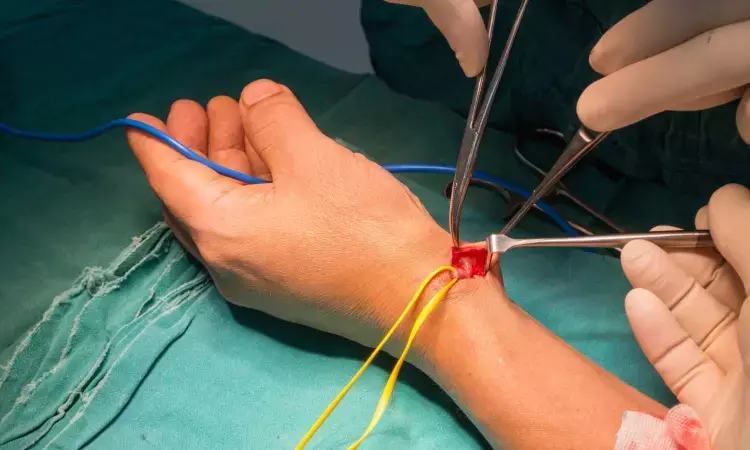- Home
- Medical news & Guidelines
- Anesthesiology
- Cardiology and CTVS
- Critical Care
- Dentistry
- Dermatology
- Diabetes and Endocrinology
- ENT
- Gastroenterology
- Medicine
- Nephrology
- Neurology
- Obstretics-Gynaecology
- Oncology
- Ophthalmology
- Orthopaedics
- Pediatrics-Neonatology
- Psychiatry
- Pulmonology
- Radiology
- Surgery
- Urology
- Laboratory Medicine
- Diet
- Nursing
- Paramedical
- Physiotherapy
- Health news
- Fact Check
- Bone Health Fact Check
- Brain Health Fact Check
- Cancer Related Fact Check
- Child Care Fact Check
- Dental and oral health fact check
- Diabetes and metabolic health fact check
- Diet and Nutrition Fact Check
- Eye and ENT Care Fact Check
- Fitness fact check
- Gut health fact check
- Heart health fact check
- Kidney health fact check
- Medical education fact check
- Men's health fact check
- Respiratory fact check
- Skin and hair care fact check
- Vaccine and Immunization fact check
- Women's health fact check
- AYUSH
- State News
- Andaman and Nicobar Islands
- Andhra Pradesh
- Arunachal Pradesh
- Assam
- Bihar
- Chandigarh
- Chattisgarh
- Dadra and Nagar Haveli
- Daman and Diu
- Delhi
- Goa
- Gujarat
- Haryana
- Himachal Pradesh
- Jammu & Kashmir
- Jharkhand
- Karnataka
- Kerala
- Ladakh
- Lakshadweep
- Madhya Pradesh
- Maharashtra
- Manipur
- Meghalaya
- Mizoram
- Nagaland
- Odisha
- Puducherry
- Punjab
- Rajasthan
- Sikkim
- Tamil Nadu
- Telangana
- Tripura
- Uttar Pradesh
- Uttrakhand
- West Bengal
- Medical Education
- Industry
Radial Access Superior for Coronary Angiography, With Distal Radial and Ulnar Access as Preferred Secondary Options, affirms study

The findings, published in Circulation: Cardiovascular Interventions, endorse radial access as the primary choice for coronary angiography, with distal radial or ulnar access recommended over femoral access as a secondary option.
Coronary angiography, a key diagnostic tool for assessing coronary artery disease, traditionally uses femoral access. However, radial access has become increasingly popular due to its lower risk of complications and quicker recovery times. Previous studies have shown that radial artery access for coronary angiography or PCI lowers the risk of death, bleeding, and vascular complications compared to femoral artery access, earning it a class 1 recommendation in clinical practice guidelines. Despite this, alternative upper extremity access options, such as distal radial and ulnar access, are not yet addressed in the guidelines, even though randomized trials support their use.
Against the above background, M Haisum Maqsood, Department of Cardiology, DeBakey Heart and Vascular Center, Methodist Hospital, TX, and colleagues aimed to evaluate procedural outcomes with femoral, radial, distal radial, and ulnar access sites in patients undergoing coronary angiography or PCI.
For this purpose, the researchers searched PubMed, EMBASE, and clinicaltrials.gov databases for randomized clinical trials comparing at least two of the four access sites in patients undergoing PCI or angiography. The primary outcomes analyzed were major bleeding and access site hematoma. An intention-to-treat mixed-treatment comparison meta-analysis was then conducted.
The researchers reported the following findings:
- From 47 randomized clinical trials that randomized 38 924 patients undergoing coronary angiography or PCI, when compared with femoral access, there was a lower risk of major bleeding with radial access (odds ratio [OR], 0.46) and lower risk of access site hematoma with radial (OR, 0.34), distal radial (OR, 0.33), and ulnar (OR, 0.50) access.
- Compared with radial access, there was a higher risk of hematoma with ulnar access (OR, 1.48).
"Evidence from randomized trials supports a Class 1 guideline recommendation favoring radial access over femoral access for coronary angiography or PCI. Additionally, when radial access is not feasible, distal radial or ulnar access should be considered as preferred alternatives before resorting to femoral access," the researchers concluded.
Reference:
Maqsood MH, Yong CM, Rao SV, Cohen MG, Pancholy S, Bangalore S. Procedural Outcomes With Femoral, Radial, Distal Radial, and Ulnar Access for Coronary Angiography: A Network Meta-Analysis. Circ Cardiovasc Interv. 2024 Jul 19:e014186. doi: 10.1161/CIRCINTERVENTIONS.124.014186. Epub ahead of print. PMID: 39027936.
Dr Kamal Kant Kohli-MBBS, DTCD- a chest specialist with more than 30 years of practice and a flair for writing clinical articles, Dr Kamal Kant Kohli joined Medical Dialogues as a Chief Editor of Medical News. Besides writing articles, as an editor, he proofreads and verifies all the medical content published on Medical Dialogues including those coming from journals, studies,medical conferences,guidelines etc. Email: drkohli@medicaldialogues.in. Contact no. 011-43720751


